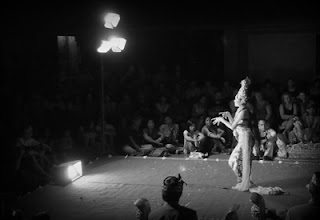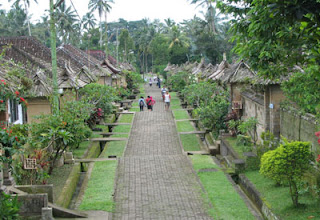Bali Personal Drivers - Puri Saren Ubud is 22 km from Denpasar Bali, you only take 35 minutes to arrive in this place. The location of Puri Saren Ubud is not difficult to be found, the traditional Balinese style building is standing stout and majestic in the midst of Ubud. Puri Saren Ubud is one proof of the preservation of Cultural heritage in Ubud and Bali, where the peoples always conserving nature and their customs in a religious ceremony in a dignified manner.
Introduction
Ubud is located on the highlands about 300 meters above sea level, its beautiful villages and the cool weather making an inspiration to anyone who came to visit. Ubud itself has become a city of the kingdom for more than a hundred years in which to date the king who has a degree "Tjokorda or Agung" and his family still live in a traditional castle called "Puri" and known as the Puri Saren Ubud.
Puri (palace) in Balinese language means the king's house. Puri Saren Ubud built by King Ida Tjokorda Putu Kandel who ruled in 1800-1823. Puri Saren Ubud open to be visited by tourists from the 1930s when King Cokorda Sukawati ruled. Until this day, the successor of the puri still allow tourists to visit the puri, while the other puri closed to the public. Although developed as a tourist attraction, but the shape and the structure of the puri building, still looks like a their initial / unchanged. Puri Saren Ubud still has a place, which is worth sacred (madya) as a residential space that should not be entered by tourists.
The changes only appear in the puri area which is profane (Nista), such as : rest house, restaurant, art shop and stage art performances for tourists. While the other puri regions is still serves as the center of social and cultural life of society. It can be seen from the routine activities performed by the people around Puri Saren Ubud.
Need to know that, other than as a residence for the king, Puri Saren Ubud also has an important role in preserving the social and cultural life of the people of Ubud. The feudal system has long been abandoned, but the presence of puri is very meaningful to the people of Ubud. Although there is no formal power as royalty, but the commands of king Ubud is still highly respected by its community.

The leaders Puri Saren Ubud has a very high attention to the development and the protection of arts and culture of Bali. One measure is to grant permission for the people of Ubud to use the front courtyard of Puri (named Ancak Saji) to learn the arts of Bali. On Saturday and Sunday morning, ranging from children to teenagers, men and women come to learn to dance and gamelan at this place. Then every night at the same venue will be staged dance and gamelan from children and teenagers to entertain the tourists.
King of Ubud with traditional village governance and the public work together to make Ubud as a polite tourist attractions, for example : at certain times, the king and the community leaders conferred in Puri Saren Ubud to develop tourism program, that raised more traditional elements of Bali. Various rules to maintain the resilience of the local culture is also negotiated in Puri Saren Ubud. Cultural tourism who developed in this place makes tourists who come are those who want to learn the culture, including dance, painting or who want to play the gamelan.
The interesting thing is the presence of rules that have been agreed among the traditional leaders, communities and stakeholders in tourism that all evening activities in Ubud, whether its restaurants, shops, art shops, or activities in small bars limited only until 11 o'clock at night. After the appointed hour, it is no longer activity 'night tour'. So the nighttime atmosphere in Ubud so quiet and peaceful. In addition, the cooperation of traditional government (the king and traditional village leaders) in Ubud, prohibit the opening of a nightclub or similar to it, because it would be considered disturbing the peace and not in accordance with traditional culture.
So that's why Ubud that was so crowded, it will not ever be glittering like Kuta. The existence of Puri Saren Ubud was so honored. The command of the king, was so be obeyed, by its community. They had tried to keep together Ubud, in order not to lose the spirit and identity as a region that respects the cultural heritage of their ancestors. Puri Saren Ubud is currently acting as a repository of Balinese traditional culture, which is a major patron of art, dance, music and literature of Bali.
Then what is Ubud not modern ...?
Ubud is very modern, for example, because the location of Puri Saren Ubud on the main road, then automatically all forms of businesses that are in the main street is a support facility for the tourists who come. Around Puri Saren Ubud there are many wonderful local style hotel, shops and boutiques internationally, money changer, as well as a variety of restaurant presenting local and international cuisine. But modernity is not to change the face of Ubud. He remains a "girl", a calm and graceful that could wrap all the slick modernity with the power of local charm which he has.
What is interesting here ...?
Puri Saren Ubud of Bali has traditional architecture that had a high aesthetic. Paduraksa gate is a complex gate into the Puri Saren Ubud. This very thick gate made of red bricks, with carved ornaments decorate ledges and other parts. The "Kala" carving seems to be on top of the inlet, with a pair of giant statues stand guard in front of the gate, as well as another pair of smaller size are in a wall niche. "Kala" is the son of Lord Shiva which is the ruling the gods of time, and as a symbol that no one man can stand against time, because when the time comes, then Kala will come to fetch. Behind the gate there is a bale which is used by visitors to rest while enjoying the atmosphere at the puri.

A typical Balinese building called "Kori Agung" stood majestically that believed to be the entry and the exit gates for the gods. Kori Agung also serves to limit between the "Jaba Tengah" (middle) with Jaba Jero (utama mandala or the inside). The doors carved with exquisite then painted with colors prada (gold). The left-right door, there is a pair of Balinese umbrella with red tassels, behind the giant statue wrapped in black and white striped traditional Balinese cloth, called saput poleng. "Saput" in Balinese language means blanket, while "poleng" means striped. Above the door there is a Kala relief as repellent reinforcements and on the left wall there is a royal symbol with golden color.
The interior of the Puri Saren Ubud you can accomplish by passing through a small gate on the right side Kori Agung. Here looked a fairly large bale where there is Gamelan of Bali, where all around him, there are statues of a giant beast with the head and body with wings. Several giant statue crowned and armed with mace also looks keep on the front bale. Paduraksa a gate, which leads to the private residence of the royal family, visitors are not invasive, and you can only see a beautiful sculpture from a distance.
Puri Saren Ubud is built with the concept of sanga mandala (the division of the castle area into nine plots). You can see how beautiful the traditional Balinese houses that decorated with Balinese carvings and painted with golden color (prada). In order not to contaminate the floor, visitors are not allowed to go up to the floor. "Do not climb up please" plastered every existing building. The main puri building here is the most substantial and full of Balinese carvings located in the northern part. This is where the King of Ubud usually received his guests. East side there is a "Bale Dangin" which functioned for the humanitarian activities like wedding, "potong gigi" (cutting teeth) and a corpse lay down before cremation. Rule here is simple "do not go up to the floor, no smoking and not noisy", but "feel free to take picture here".
One more thing, the puri also provides an opportunity for those who want to feel a part of the royal family by renting rooms that were there. If interested, you can ask the receptionist, who served in front of the puri area. Welcome to the royal family house.
Reference : wisatadewata.com
Photo : flickr.com, commons.wikimedia.org
Bali Personal Drivers





